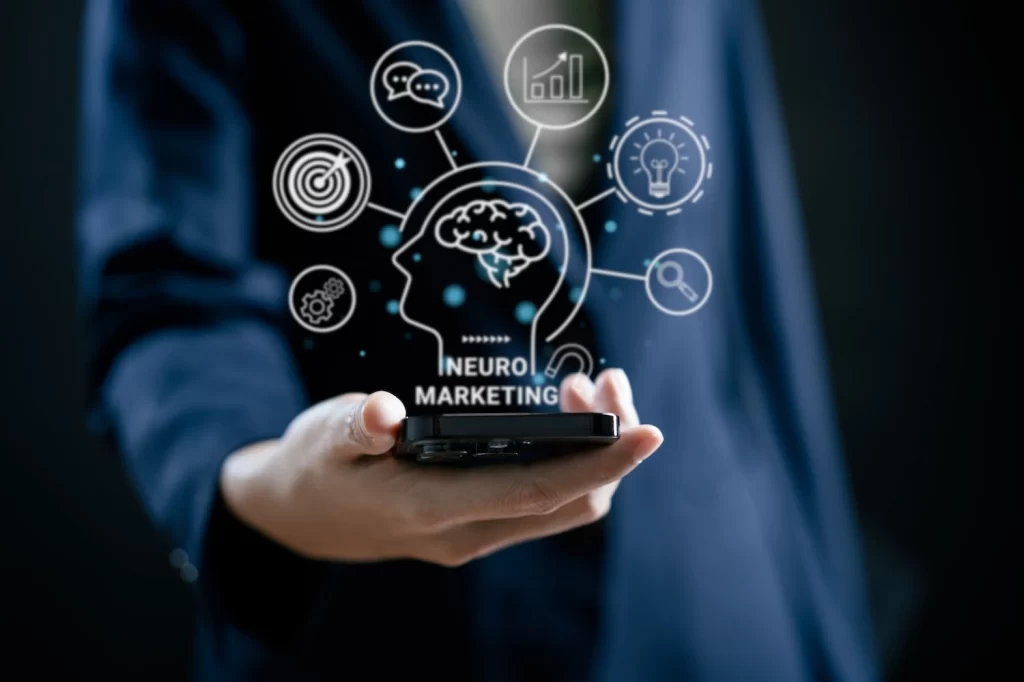Neuromarketing, a powerful field at the intersection of neuroscience and marketing, is quickly reshaping the way businesses understand and engage with consumers. By analyzing brain responses and other physiological indicators, neuromarketing helps companies identify what truly captivates consumers, enabling them to optimize their branding, advertising, and overall business strategy. In this blog, we’ll explore the fundamentals of neuromarketing, its techniques, and the ways it influences business performance.
What is Neuromarketing?
Neuromarketing involves using neuroscientific tools and methods to study consumers’ non-conscious reactions to various marketing stimuli. While traditional marketing relies on surveys and focus groups, neuromarketing delves deeper, analyzing physiological signals like brain activity, eye movement, and heart rate to reveal underlying preferences and emotional triggers. By understanding these non-conscious responses, businesses gain insights into how consumers truly perceive their products, services, and brand messages.
Why is Neuromarketing Important?
Consumers are often influenced by unconscious emotions and biases when making purchasing decisions. Traditional methods like surveys may reveal only a fraction of a customer’s preferences and are prone to bias, as people may not always express their true feelings. Neuromarketing provides insights that go beyond verbal feedback, uncovering subconscious responses that more accurately reflect consumer preferences.
Through neuromarketing, businesses can answer critical questions:
- What elements of an advertisement capture the audience’s attention?
- How does brand messaging resonate emotionally with consumers?
- Which aspects of product design or packaging appeal most to target demographics?
Key Neuromarketing Techniques and Tools
- QEEG (Quantitative Electroencephalography)
QEEG is used to monitor brain activity in real-time. QEEG measures electrical activity in the brain, which helps identify specific responses to different stimuli. This method provides insights into consumer engagement, emotional arousal, and memory retention.

- Eye Tracking
Eye-tracking technology monitors where and how long a person looks at different parts of an advertisement, website, or product. This technique helps marketers identify visual elements that capture attention and whether the design or layout needs adjustments to enhance user experience.
- Facial Expression Analysis
By analyzing subtle changes in facial expressions, this method captures emotional responses like joy, surprise, disgust, or frustration. Facial analysis is beneficial in gauging real-time reactions to advertisements, product packaging, or customer service interactions, helping businesses refine their approach based on how consumers feel.
- ERP (Event-Related Potential)
ERP is a technique derived from EEG that measures the brain’s direct response to specific sensory, cognitive, or motor events. It provides insights into how quickly and intensely a person responds to various marketing stimuli, such as images, slogans, or sound bites. By identifying which elements of a campaign resonate most with the audience, ERP helps companies fine-tune their strategies to create a stronger emotional impact.
- Heart Rate Monitoring
Heart rate variability can also indicate emotional responses. For example, a faster heart rate may suggest excitement or anticipation, while a slower rate could indicate calm or disinterest. Heart rate data can reveal how emotionally stimulating a marketing campaign or brand interaction is for consumers.

Effects of Neuromarketing on Business Performance
- Improved Customer Engagement and Brand Loyalty
Neuromarketing insights enable businesses to create campaigns that truly resonate with their audience. When companies know what grabs attention and evokes positive emotions, they can design more memorable and engaging campaigns. Emotional engagement strengthens brand loyalty, as consumers are more likely to support brands that make them feel understood and valued.
- Enhanced Product and Packaging Design
Neuromarketing can guide product design by revealing elements that appeal most to consumers. Through eye tracking and EEG, businesses can test different product prototypes, packaging colors, and textures to ensure their final product aligns with consumer preferences. An optimized design not only boosts appeal but can also lead to increased sales and brand differentiation.
- Maximized Advertising Effectiveness
Advertising is one of the largest expenses in marketing, and neuromarketing helps companies make it more effective. By understanding which ad elements captivate audiences, companies can avoid costly trial-and-error approaches, ultimately optimizing their ad spend. Techniques like EEG and GSR help businesses create content that connects with viewers, leading to better recall and a higher return on investment (ROI).
- Optimized Website and Digital Experience
Neuromarketing isn’t limited to physical products or advertisements; it’s also highly effective for digital experiences. Eye tracking and facial expression analysis help designers create websites that are intuitive and visually appealing. By understanding where users focus their attention, businesses can enhance user experience (UX) and ensure that calls-to-action (CTAs) are positioned effectively, leading to better conversion rates.
- Reduced Risk of Product Launch Failures
Product launches can be costly, and the wrong approach may lead to significant losses. Neuromarketing allows businesses to test products and marketing materials before launch, providing a clearer picture of potential consumer reactions. This helps companies reduce the risk of failure by adjusting their strategy or design based on pre-launch neuromarketing feedback.

Case Studies: Real-World Applications of Neuromarketing
Coca-Cola and Emotional Engagement
Coca-Cola has employed neuromarketing to refine its advertising strategies, especially its holiday campaigns, which are well-known for emotional appeal. Using EEG and GSR, Coca-Cola’s neuromarketing team measured consumer reactions to various ad versions. The most emotionally engaging elements were highlighted, leading to a final product that generated strong positive responses and reinforced brand loyalty.
Hyundai and Car Design
Hyundai used eye tracking and EEG technology to test different car models and identify design features that sparked positive reactions in potential customers. The insights gained allowed Hyundai to create models with features most likely to attract buyers, ultimately boosting sales and brand perception in the highly competitive automotive market.
Google’s Digital Design with Eye Tracking
Google has used eye tracking to refine its interface designs, ensuring users can easily navigate and find information. By observing where users looked first, Google was able to design pages that felt more intuitive, leading to a better user experience and increased satisfaction.
Debunking Neuromarketing Myths
Myth 1: Neuromarketing Manipulates Consumers
Fact: Neuromarketing does not control or manipulate; it aims to understand consumers better. By aligning with actual preferences and needs, it allows companies to create more personalized experiences rather than pushing unwanted messages.
Myth 2: Only Big Companies Use Neuromarketing
Fact: While initially more common among large corporations, neuromarketing tools have become more accessible to small and medium-sized businesses. Even a basic understanding of consumer responses can enhance marketing strategies for companies of all sizes.
Myth 3: Neuromarketing Guarantees Success
Fact: Neuromarketing can enhance strategies, but it’s not a guaranteed solution. It provides insights that help reduce risk and optimize effectiveness, but external factors, market trends, and individual preferences still influence outcomes.
How Neuromarketing Benefits Businesses of All Sizes
The insights gained from neuromarketing allow businesses to make smarter, data-driven decisions. By understanding consumer motivations and emotions, companies can foster stronger connections with their audience and stand out in competitive markets. Neuromarketing isn’t just a tool for large corporations; small businesses, too, can gain valuable insights to improve their marketing effectiveness.
Conclusion: The Future of Marketing is Neuromarketing
Neuromarketing has the power to revolutionize how companies approach their customers, giving them the ability to create personalized, emotionally resonant experiences. By understanding consumer preferences on a deeper level, businesses can not only improve customer satisfaction but also increase brand loyalty and profitability.
For companies looking to stay ahead, neuromarketing offers a competitive edge in today’s fast-paced market. As the field continues to evolve, we can expect to see even more innovative applications, making neuromarketing an invaluable tool in any business’s arsenal.
Elumind Centres for Brain Excellence is an integrated brain health center offering solutions to help you with your needs. To have a better understanding of our procedure in neuromarketing projects, book your call. We are here for you.








